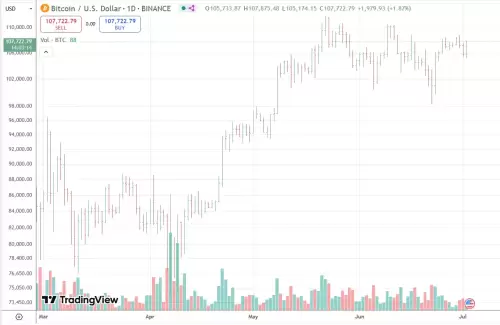 |
|
 |
|
 |
|
 |
|
 |
|
 |
|
 |
|
 |
|
 |
|
 |
|
 |
|
 |
|
 |
|
 |
|
 |
|
Nachrichtenartikel zu Kryptowährungen
Flash Loan Attack Drains 500K USD From CloberDEX on Base
Dec 26, 2024 at 09:05 am

Recently, an on-chain attack was detected against CloberDEX, a project on Base. The attacker gained about 133 ETH, or about 500,000 USD, through this attack.
The attacked project is CloberDEX, and its main functions are as follows: open a new trading pool containing trading pairs A to B and B to A, and each trading pair also contains a preset trading strategy; mint is to add liquidity to the trading pair and obtain LP Token; burn is to destroy LP Token to obtain the corresponding currency.
Let's take a look at the attack process:
First, the attacker borrowed 267 WETH from Morpho Blue using flashloan.
Then, the attacker used open to open two trading pairs on CloberDEX, namely Token/WETH and WETH/Token, where Token is a contract deployed by the attacker himself.
Then, the attacker used mint to transfer 267 WETH and 267 Token to the newly opened trading pair to add liquidity and obtain LP Token.
So far, there is no problem. Finally, the attacker uses burn to destroy the LP Token just obtained. Let's take a look at the specific implementation of burn;
The control flow goes to the lock function. Similarly, let's take a look at the specific implementation of lock;
As you can see, the lock function passes bytes caldata data to the lockAcquired function. Let's continue to look at the implementation of this function.
We found this line of code
We can see that the function called by the code is determined by data. The first four bytes of data are the signature of _burn, so burn essentially calls _burn.
We can see that _burn calls pool.strategy.burnHook(msg.sender, key, burnAmount,supply) again, and the processing of the pool's reserver comes after this code. So, the problem lies here. The address of the strategy contract of the pool corresponding to the trading pair can be controlled by the attacker. In this attack, the attacker wrote the address as his own attack contract address: 0x32fb1bedd95bf78ca2c6943ae5aeaeaafc0d97c1 .
When the contract process reaches the BurnHook of the attacking contract, burn is called again to complete the reentrancy attack.
The attacker took out 264 WETH and 133 WETH from the CloberDEX contract through this vulnerability, and made a profit of 133.7 ETH after repaying the flashloan loan, which is about 500,000 USD.
The main cause of this vulnerability is that the CloberDEX project contract did not perform reentrancy detection and protection in the code for obtaining and destroying LP Tokens, and the state variables were updated after the contract was called, which eventually led to the attacker using the reentry vulnerability to empty the project's WETH. It is recommended that the project party should conduct multi-party verification when designing the economic model, price calculation mechanism and code operation logic, and try to select multiple audit companies for cross-audit when auditing the contract before it goes online.
Haftungsausschluss:info@kdj.com
Die bereitgestellten Informationen stellen keine Handelsberatung dar. kdj.com übernimmt keine Verantwortung für Investitionen, die auf der Grundlage der in diesem Artikel bereitgestellten Informationen getätigt werden. Kryptowährungen sind sehr volatil und es wird dringend empfohlen, nach gründlicher Recherche mit Vorsicht zu investieren!
Wenn Sie glauben, dass der auf dieser Website verwendete Inhalt Ihr Urheberrecht verletzt, kontaktieren Sie uns bitte umgehend (info@kdj.com) und wir werden ihn umgehend löschen.
-

- Robert Kiyosaki immer noch bullisch bei Bitcoin: Warum 107.000 Dollar "billig" ist
- Jul 02, 2025 at 08:30 pm
- Robert Kiyosaki, der Autor der reichen Vater, verdoppelt Bitcoin und betrachtet sogar 107.000 US -Dollar als Schnäppchen. Entdecken Sie, warum er noch kauft und seine mutige Vorhersage von 1 Million Dollar.
-

-

- Sofortige Zahlungen, Fintech und USDC Stablecoins: Eine neue Ära der Finanzen?
- Jul 02, 2025 at 06:30 pm
- Erkundung der Schnittstelle zwischen sofortigen Zahlungen, Fintech -Innovation und dem Aufstieg von USDC Stablecoins und dem transformativen Potenzial für Unternehmen und Verbraucher gleichermaßen.
-

-

-

-

-

-

- Bitcoin Breakout Watch: Technische Daten weisen auf potenzielle Aufwärtstrend hin, ya dig?
- Jul 02, 2025 at 07:15 pm
- Bitcoin zeigt Resilienz von rund 107.000 US -Dollar. Technische Indikatoren deuten auf einen potenziellen Ausbruch auf, wobei institutionelle Interesse und Makrofaktoren wichtige Rollen spielen. Ist eine Rallye auf 143.000 US -Dollar als nächstes?






























































